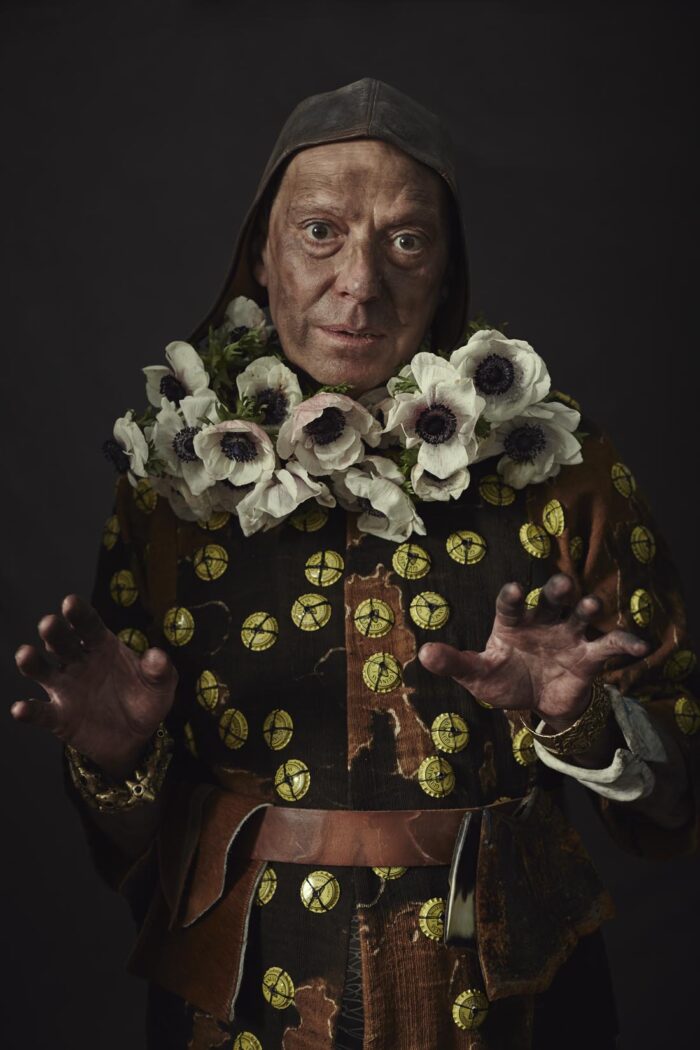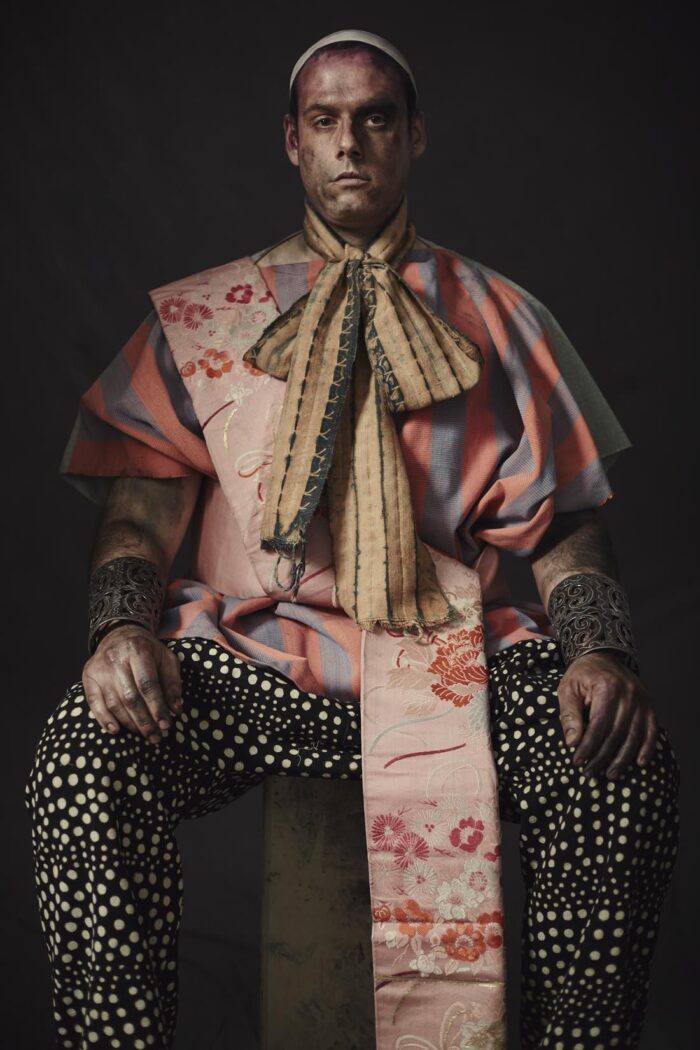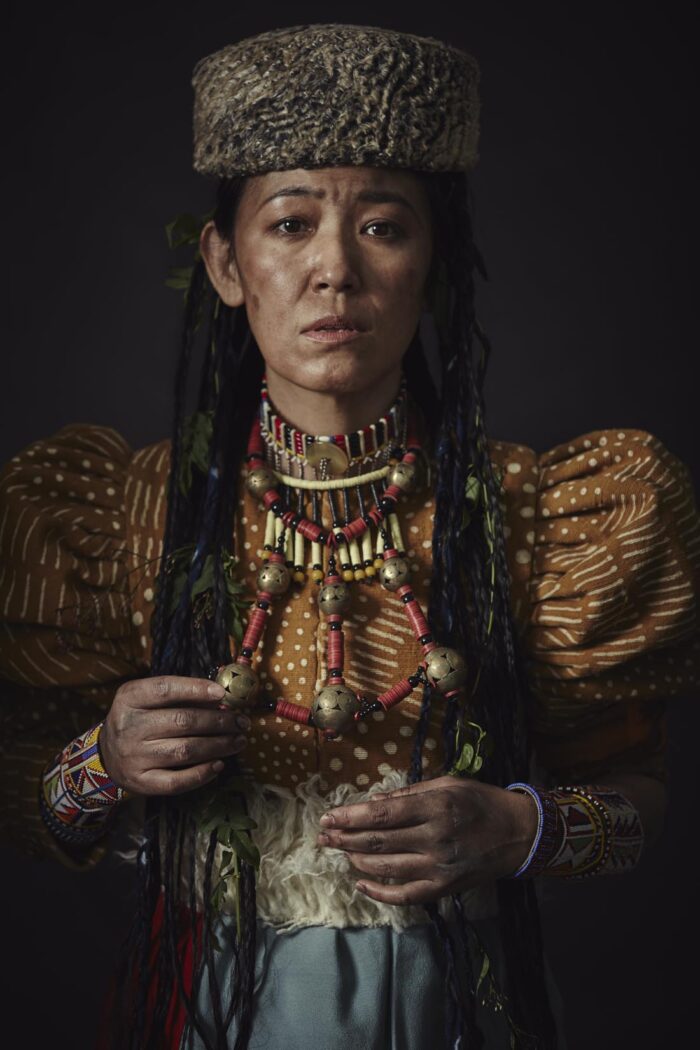“We believe art remains a step ahead and guides where fashion goes” Simone Cipriani, Head and Founder of the Ethical Fashion Initiative.
Inspired by the paintings of Pieter Bruegel and August Strindberg’s A Dream Play, a new play Elijah Green follows a divine spirit as it wanders through contemporary life. Despite unremarkable existences, the stories of the characters layer into a portrait of the interconnectivity of all humans, with each individual both the centre of the world and part of something they cannot comprehend.
The writer, director and designer Andrew Ondrejcak has connected with artisans from Burkina Faso, Mali, Kenya and Haiti to create the costume collection for his upcoming play, in collaboration with the ITC Ethical Fashion Initiative. The costumes will feature hand-painted bogolan fabric from Mali, hand-woven danfani fabric from Burkina Faso, Maasai jewellery from Kenya and fer decoupé and papier-mâché accessories from Haiti.

Andrew Ondrejcak travelled with ITC’s Ethical Fashion Initiative to Haiti, Burkina Faso and Mali to meet with artisans and source fabric, jewellery, art and items to create the costumes and the play’s set. In Burkina Faso, Andrew Ondrejcak discovered fabric handwoven by women weavers and in Mali he received a crash course in the art of bogolan by master artisan, Boubacar Doumbia.
While in Haiti, Andrew Ondrejcak was able to meet with a wide variety of artisans to source latanier hats, papier-mâché accessories and tailor made metal drum pieces and many more. ITC Ethical Fashion Initiative also sourced traditional Kenyan Maasai jewellery and samples of Kenyan crafts.
Produced by Tanya Selvaratnam and Tommy Kriegsmann/ArKtype, Elijah Green will premiere on 10 March 2016 at The Kitchen in New York. The play will be showing at 8pm from March 10-12 and 17-19. In addition, Andrew Ondrejcak will do a post-show Q&A with costume collaborators from EFI and Alba Clemente on March 17th. Find out more
About ITC Ethical Fashion Initiative
The Ethical Fashion Initiative is a flagship programme of the International Trade Centre, a joint agency of the United Nations and the World Trade Organization. The Ethical Fashion Initiative works with the rising generation of fashion talent from Africa, encouraging the forging of fulfilling creative collaborations with artisans on the continent. The Ethical Fashion Initiative also enables artisans living in urban and rural poverty to connect with the global fashion chain. Under its slogan, “NOT CHARITY, JUST WORK.” the Ethical Fashion Initiative advocates a fairer global fashion industry.
Photo credits: Georgia Neirheim
It still strikes me as profoundly wrong that even though cotton is the world’s oldest commercial crop and one of the most important fibre crops in the global textile industry, the industry generally fails to focus on the entire value chain to ensure that those who grow their cotton also receive a living income.
Up to 100 million smallholder farmers in more than 100 countries worldwide depend on cotton for their income. They are at the very end of the supply chain, largely invisible and without a voice, ignored by an industry that depends on their cotton.
When it comes to clothing, companies’ supply chain engagement was once limited to who their importer was. Now they are engaging with their supply chain more and have better awareness of the factories used to manufacture their end products. Even before the Rana Plaza disaster of 2013, there had been increased attention on improving the conditions experienced by textile factory workers thanks to campaigns such as the Clean Clothes Campaign.
Some companies also have awareness beyond the factories and these are all movements in the right direction. However, even those mindful of the difficulties faced by factory workers, tend to miss the first links in the supply chain.
Maybe this is because cotton farmers continue to somehow lose out in both the so-called ‘sustainable’ and ‘ethical’ fashion debates. When companies talk about ‘sustainability’ in their clothing supply chains, they are generally looking at the environmental impact of sourcing the raw materials. Meanwhile in ‘ethical’ conversations about the many livelihoods touched by the garment value chain, companies generally refer to factory workers, again overlooking the farmer who grows the seed cotton that goes into our clothing.
The reason we need to keep insisting that cotton farmers are an important part of the fashion supply chain is because cotton is failing to provide a sustainable and profitable livelihood for the millions of smallholders who grow the seed cotton the textile industry depends on. Just as it’s important for us to take home a living wage, to help bring a level of security for our families and the ability to plan for the future, I would argue that this is even more vital for people living in poorer countries where there is little provision for basic services such as health and education or the safety net of social security systems to fall back on.
As a global commodity, cotton plays a major role in the economic and social development of emerging economies and newly industrialised countries. It is an especially important source of employment and income within West and Central Africa, India and Pakistan.
Many cotton farmers live below the poverty line and are dependent on the middle men or ginners who buy their cotton, often at prices below the cost of production. And rising costs of production, fluctuating market prices, decreasing yields and climate change are daily challenges, along with food price inflation and food insecurity. These factors also affect farmers’ ability to provide decent wages and conditions to the casual workers they employ. In West Africa, a cotton farmer’s typical smallholding of 2-5 hectares provides the essential income for basic needs such as food, healthcare, school fees and tools. A small fall in cotton prices can have serious implications for a farmer’s ability to meet these needs. In India many farmers are seriously indebted because of the high interest loans needed to purchase fertilisers and other farm inputs. Unstable, inadequate incomes perpetuate the situation in which farmers lack the finances to invest in the infrastructure, training and tools needed to improve their livelihoods.
However research shows that a small increase in the seed cotton price would significantly improve the livelihood of cotton farmers but with little impact on retail prices. Depending on the amount of cotton used and the processing needed, the cost of raw cotton makes up a small share of the retail price, not exceeding 10 percent. This is because a textile product’s price includes added value in the various processing and manufacturing activities along the supply chain. So a 10 percent increase in the seed cotton price would only result in a one percent or less increase in the retail price – a negligible amount given that retailers often receive more than half of the final retail price of the cotton finished products.
Within sustainable cotton programmes, Fairtrade works with vulnerable producers in developing countries to secure market access and better terms of trade for farmers and workers so they can provide for themselves and their families.
Our belief is that people are increasingly concerned about where their clothes come from. This year we visited cotton farmers in Pratibha-Vasudha, India, a Fairtrade co-operative in Madhya Pradesh. We saw the safety net that Fairtrade brings; the promise of a minimum price that works in a global environment. The impact on prices of subsidised production in China and the US adds to unstable global cotton prices. These farmers democratically decide how the Fairtrade Premium is spent: on training to improve soil and productivity, strategies to mitigate the impacts of climate change and on the most important ways for their communities to benefit, such as building health centres and educating children.
Consumers want their clothes made well and ethically, without harmful agrochemicals and exploitation. We think about farmers when we talk about food. Let’s start thinking about farmers when we think about clothing too.
Image credits: Trevor Leighton.





